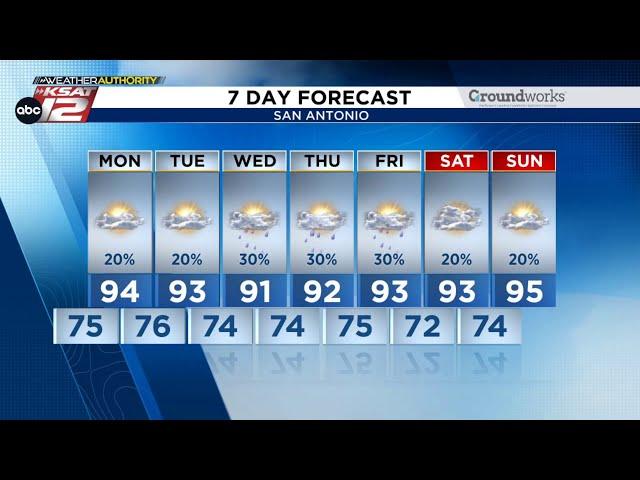Nationwide Heatwave Contrasts with San Antonio’s Persistent Rainfall
Across much of the United States, a significant surge in temperatures is pushing summer heat into areas that typically experience milder conditions. From the bustling cities of the Northeast to the coastal regions of the West, thermometers are registering highs well above seasonal averages, prompting increased energy use as air conditioning units work overtime. Public health officials are raising alarms about the heightened risk of heat-related ailments, urging communities to take necessary precautions.
In stark contrast, San Antonio is witnessing a weather pattern dominated by frequent, heavy rain showers occurring almost daily. This moisture-rich environment is causing localized flooding and interrupting daily routines, setting the city apart from the broader national trend of relentless heat. Below is an overview of temperature highs and precipitation forecasts for select metropolitan areas this week:
| City | Average High (°F) | Precipitation Outlook |
|---|---|---|
| San Antonio, TX | 88 | Frequent daily showers |
| New York, NY | 92 | Intermittent thunderstorms |
| Seattle, WA | 81 | Predominantly dry |
| Chicago, IL | 94 | Occasional rain |
- Heat warnings remain active in multiple urban centers.
- Flash flood alerts have been issued for the San Antonio area.
- Residents are encouraged to stay hydrated and keep abreast of weather advisories.
San Antonio’s Daily Rainfall Amid Warm and Humid Conditions
San Antonio is currently experiencing a distinctive weather cycle marked by afternoon and evening thunderstorms fueled by warm, moisture-heavy air masses. These daily rain events provide some respite from the heat but also lead to frequent interruptions in traffic flow and outdoor plans. Meteorologists link this phenomenon to a stationary atmospheric system that traps humidity over the region, generating intense yet short-lived storms each day.
Despite the rainfall, temperatures remain relatively high, contrasting with other U.S. cities where heat indices are even more extreme. Residents are advised to remain alert as weather conditions swing between sunny spells and sudden downpours. Key consequences of this pattern include:
- Localized flooding in flood-prone neighborhoods
- Delays in transportation during peak storm periods
- Elevated humidity levels increasing discomfort
| Day | High Temperature (°F) | Probability of Rain (%) | Peak Rainfall Times |
|---|---|---|---|
| Monday | 87 | 70 | 4 PM – 8 PM |
| Tuesday | 88 | 65 | 3 PM – 7 PM |
| Wednesday | 89 | 75 | 5 PM – 9 PM |
Consequences of Intense Rainfall on San Antonio’s Residents and Infrastructure
The ongoing heavy rain episodes in San Antonio have posed significant challenges for local inhabitants, disrupting everyday activities and stretching municipal resources thin. Flooded roadways have made commuting perilous and unpredictable, while many homes, particularly in lower-lying districts, are experiencing water intrusion that leads to property damage and potential health hazards. Emergency services report a surge in calls related to water rescues and infrastructure breakdowns, highlighting the community’s vulnerability. Temporary closures of schools and businesses have further impacted the local economy.
Infrastructure systems are also under pressure, revealing weaknesses in drainage and transportation networks. Roads damaged by persistent water exposure create hazards for drivers, and electrical utilities face risks of outages as substations become flooded. The table below outlines the most affected zones and their respective impacts:
| Location | Primary Issue | Community Impact |
|---|---|---|
| Downtown San Antonio | Flash Flooding | Business interruptions; transit delays |
| Southside Neighborhood | Residential Flooding | Evacuations; property damage |
| Highways 281 & 410 | Road Erosion and Washouts | Traffic rerouting; repair operations |
- Overburdened sewer systems causing backflow and contamination concerns.
- Heightened demand on emergency responders, leading to longer wait times.
- Power disruptions due to flooded electrical infrastructure, affecting thousands.
This persistent weather pattern underscores the critical need for enhanced infrastructure resilience and comprehensive community preparedness initiatives to better withstand future climate variability.
Essential Safety Guidelines for Residents Amidst Heavy Rainfall
Stay updated by regularly checking reliable weather sources such as the National Weather Service or local outlets like KSAT. Keep a battery-operated or hand-crank radio available in case of power failures, and subscribe to emergency notifications on your mobile device. Awareness of flood-prone zones is crucial—avoid travel during intense rain to reduce the risk of becoming trapped or encountering dangerous conditions.
Proactive preparation can significantly reduce risks. Assemble an emergency supply kit containing essentials like bottled water, non-perishable foods, flashlights, spare batteries, and first aid materials. Ensure that gutters and drainage channels around your home are free from debris to minimize flooding risks. In the event of flash floods, adhere to these safety recommendations:
- Never attempt to drive through flooded streets or roadways.
- Seek higher ground immediately if water levels rise rapidly.
- Keep extra blankets and warm clothing accessible for sudden temperature drops.
| Recommended Action | Purpose | Priority Level |
|---|---|---|
| Clear Gutters and Drains | Prevents water accumulation and structural damage | High |
| Prepare Emergency Kit | Ensures access to vital supplies if isolated | High |
| Monitor Weather Alerts | Provides timely warnings to avoid hazards | Medium |
In Summary
As San Antonio endures ongoing daily rainfall, contrasting with the escalating heat waves affecting much of the United States, the nation faces a complex mosaic of climate challenges. While some areas battle soaring temperatures, San Antonio’s persistent showers highlight the diverse weather phenomena shaping regional forecasts. Staying vigilant, informed, and prepared is vital for residents as these dynamic conditions continue to evolve in the coming days.




